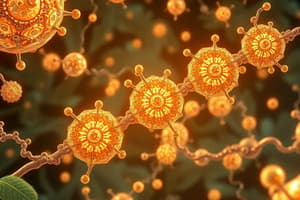Podcast
Questions and Answers
What is the main role of enzymes in biological systems?
What is the main role of enzymes in biological systems?
- Decrease the rate of chemical reactions
- Consume substrates during reactions
- Alter themselves during reactions
- Act as essential catalysts (correct)
How do enzymes speed up chemical reactions?
How do enzymes speed up chemical reactions?
- By increasing activation energy
- By altering themselves permanently
- By lowering activation energy (correct)
- By consuming substrates
What factors can influence the rate of enzyme reactions?
What factors can influence the rate of enzyme reactions?
- Time and pressure
- Color of the enzyme
- Temperature, acidity, and substrate concentration (correct)
- Volume of the enzyme solution
What happens to enzymes at high temperatures?
What happens to enzymes at high temperatures?
What is enzyme activity a measure of?
What is enzyme activity a measure of?
Why are enzymes considered biological catalysts?
Why are enzymes considered biological catalysts?
Which statement best describes the role of enzymes in chemical reactions?
Which statement best describes the role of enzymes in chemical reactions?
How does the active site of an enzyme contribute to its function?
How does the active site of an enzyme contribute to its function?
What is the primary difference between the lock-and-key model and the induced-fit model of enzyme-substrate interactions?
What is the primary difference between the lock-and-key model and the induced-fit model of enzyme-substrate interactions?
How can enzymes increase the rate of a reaction?
How can enzymes increase the rate of a reaction?
Which of the following statements about enzyme activity is true?
Which of the following statements about enzyme activity is true?
What is the primary advantage of the induced-fit model over the lock-and-key model in explaining enzyme-substrate interactions?
What is the primary advantage of the induced-fit model over the lock-and-key model in explaining enzyme-substrate interactions?
Flashcards are hidden until you start studying
Study Notes
Enzyme Reactions
Understanding the world around us requires a solid foundation in science, specifically the study of matter and energy transformations. Emphasizing physical entities and their interactions, chemistry offers insights into the molecular basis of everyday phenomena. At the heart of these reactions are enzymes, biological catalysts that increase the rate of virtually all chemical reactions within cells. Whether it's the synthesis of glucose in photosynthesis or the decomposition of starch in digestion, these catalysts play an essential role in maintaining life.
The Role of Enzymes
Proteins are central players in biological systems, and a large proportion of them serve as enzymes, acting as essential catalysts. By definition, enzymes increase the rate of chemical reactions without being consumed or altered themselves. They function by lowering the activation energy required for a reaction to occur, thereby enabling reactions that would otherwise take years to occur in a fraction of a second.
Enzyme Kinetics
Enzyme activity is a measure of how fast an enzyme can convert a substrate into a product. Factors such as temperature, acidity, and substrate concentration can affect the rate of enzyme reactions. Enzymes work best under certain conditions, and their activity can be influenced by changes in these conditions. For example, high temperatures can denature enzymes, rendering them inactive. Similarly, some enzymes are only active in specific pH ranges, and changes in pH can significantly impact their activity.
Enzyme Mechanisms
Enzymes work by providing a specific environment for reactions to occur. They bind their substrates to form an enzyme-substrate complex, which allows the reaction to proceed more quickly. The active site of the enzyme is a region that precisely matches the shape of the substrate, ensuring a high rate of reaction. Additionally, enzymes can alter the conformation of their substrates to more closely resemble the transition state, further increasing the reaction rate.
Lock-and-Key Model and Induced Fit
The lock-and-key model is a simple way to understand enzyme-substrate interactions. In this model, the enzyme has a specific shape that matches the substrate, allowing the substrate to bind and undergo a chemical reaction. However, in many cases, enzyme-substrate interactions are more complex. The induced-fit model proposes that the enzyme and substrate both undergo conformational changes upon binding, better aligning them for the reaction to occur. This model provides a more nuanced understanding of enzyme-substrate interactions.
In summary, enzymes are crucial biological catalysts that enable a wide range of chemical reactions to occur at a much faster rate than they would without them. Understanding enzyme mechanisms and their role in biochemical reactions provides valuable insights into the workings of biological systems.
Studying That Suits You
Use AI to generate personalized quizzes and flashcards to suit your learning preferences.




